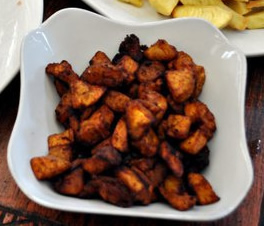Facts About Kelewele
Plantains, often referred to as cooking bananas, are a distinctive variety of banana known for their starchy texture and versatility in culinary applications. Unlike the sweet bananas commonly eaten raw, plantains are typically cooked before consumption. They are a dietary staple in many cultures, particularly in regions where they are cultivated, such as West Africa, East Africa, Central and South America, the Caribbean, and Southeast Asia. Due to their high starch content, plantains are often boiled, fried, or cooked while still green. In some African countries, plantains are even processed into flour or used in beer production.
One of the most popular ways to enjoy plantains is by frying them. This dish goes by different names depending on the region: alloco, dodo, kelewele, patacones, and tostones. Fried plantains can be savored as a snack, appetizer, or side dish, and frequently accompany main courses like Jollof rice, barbecued meat, stews, or beans.
Alloco is a beloved snack in West Africa, made from fried plantains and typically served with chili pepper and onions. In Ghana, a cherished dish called kelewele consists of fried plantains seasoned with a mix of spices. It's a common street food, often enjoyed with bean stew or peanuts, and has even gained popularity in the United States.
To prepare kelewele, begin by peeling and cutting the plantains. Next, season them with spices such as ginger, cayenne pepper, and salt before frying them until they develop a delicious caramelized sugar crust with brown edges. Additional spices, such as onions, anise, cloves, nutmeg, and cinnamon, can be added for extra flavor. For convenience, commercial spice mixes are available to help achieve a consistent taste every time.

 Burkina Faso
Burkina Faso